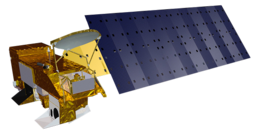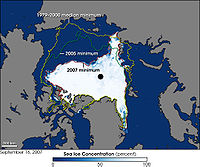cosmos.wikisort.org - Spacecraft
Aqua (EOS PM-1) is a NASA scientific research satellite in orbit around the Earth, studying the precipitation, evaporation, and cycling of water. It is the second major component of the Earth Observing System (EOS) preceded by Terra (launched 1999) and followed by Aura (launched 2004).
 Aqua (EOS PM-1) | |
| Mission type | Earth observation |
|---|---|
| Operator | NASA |
| COSPAR ID | 2002-022A |
| SATCAT no. | 27424 |
| Website | aqua.nasa.gov |
| Mission duration | 6 years (planned) Elapsed: 20 years, 5 months, 4 days |
| Spacecraft properties | |
| Bus | T330 (AB-1200) |
| Manufacturer | TRW |
| Launch mass | 3,117 kilograms (6,872 lb) |
| Dimensions | 4.81 m × 16.7 m × 8.04 m (15.8 ft × 54.8 ft × 26.4 ft) |
| Power | 4.444 kilowatts |
| Start of mission | |
| Launch date | May 4, 2002, 09:54:58 UTC |
| Rocket | Delta II 7920-10L |
| Launch site | Vandenberg SLC-2W |
| Contractor | Boeing |
| Orbital parameters | |
| Reference system | Geocentric |
| Regime | Low Earth |
| Semi-major axis | 7,080.6 kilometers (4,399.7 mi) |
| Eccentricity | 0.0000979 |
| Perigee altitude | 702 kilometers (436 mi) |
| Apogee altitude | 703 kilometers (437 mi) |
| Inclination | 98.1987° |
| Period | 99 minutes |
| RAAN | 95.2063° |
| Argument of perigee | 120.4799° |
| Mean anomaly | 351.4268° |
| Mean motion | 14.57116559 |
| Epoch | 02 June 2016, 10:25:37 UTC |
| Revolution no. | 74897 |
 Logotype of the mission. | |
The name "Aqua" comes from the Latin word for water. The satellite was launched from Vandenberg Air Force Base on May 4, 2002, aboard a Delta II rocket. Aqua operated in a sun-synchronous orbit as the third in the satellite formation called the "A Train" with several other satellites (OCO-2, the Japanese GCOM W1, PARASOL, CALIPSO, CloudSat, and Aura) for most of its first 20 years; but in January 2022 Aqua left the A-Train (as CloudSat, CALIPSO and PARASOL had already done) when, due to its fuel limitations, it transitioned to a free-drift mode, wherein its equatorial crossing time is slowly drifting to later times, from its tightly controlled orbit.[1]
Mission
Aqua is one of NASA's missions for Earth science operating in the A-Train constellation. It has demonstrated a very high level of precision in making the primary long-term measurements of the mission. These highly calibrated climate quality measurements of radiance, reflectance, and backscatter have been used to cross-calibrate past and present sensors launched by NASA, as well as a variety of sensors launched from other agencies and the international community. Thousands of scientists and operational users from around the world have made use of the Aqua data to address NASA's 6 interdisciplinary Earth science focus areas: Atmospheric Composition, Weather, Carbon Cycle and Ecosystems, Water and Energy Cycle, Climate Variability and Change, and Earth Surface and Interior.
Aqua has experienced some minor, non-mission ending anomalies.
Because of a 2007 anomaly with the Solid State Recorder (SSR) it can only hold two orbits worth of data. A series of solar array and array regulator electronics anomalies starting in 2010 has led to the loss of 23 strings of solar cells out of a total of 132 strings.[2] A 2005 short circuit within a battery cell led to a partial loss of cell capacity. In 2009, a solar panel thermistor failed and an error in the Solar Array offset was detected. The offset issue has been corrected periodically since then. On September 8, 2007, the Dual Thruster Module (DTM-2) Heater experienced an anomaly.[3] On August 16, 2020, The Formatter Multiplexer Unit (FMU) experienced an anomaly, corrupting some data in the SSR and stopping all data streams until it was recovered on September 2, 2020.[4]
The current end of mission plan is to let Aqua's orbit decay naturally at least until June 2024 and continue data collection into 2026 or even 2027, dependent on such items as budget, fuel, hardware, power, and end-of mission requirements.[2] Aqua's life could be extended with a possible re-fueling mission. A worst-case scenario would result in a re-entry by 2046.[5]
Instruments
Aqua carries six instruments for studies of water on the Earth's surface and in the atmosphere, of which four are still operating:
- Advanced Microwave Scanning Radiometer-EOS (AMSR-E) — measures cloud properties, sea surface temperature, near-surface wind speed, radiative energy flux, surface water, ice and snow. Furnished by the National Space Development Agency of Japan. The AMSR-E instrument had over 480 pounds of spinning mass, and the lubricant in the bearing assembly gradually deteriorated over the course of the mission. By 2007, there was a noticeable increase in motor current. This led to the development of new contingency procedures in case of high current or torque, which were put in place in 2011. In October 2011, the instrument began to cause yaw vibrations in the spacecraft that exceeded torque limits and on October 4, 2011, was automatically slowed to 4 rpm from the normal 40 rpm and then, because it could not maintain 4 rpm, was slowed to a stop.[6] A recovery procedure was developed and tested through 2012, culminating with a December 4, 2012 successful acceleration to 2.0767 rpm to allow for cross-calibration with the AMSR-2 instrument launched in 2012 aboard the GCOM-W1 satellite.[7] On December 4, 2015, AMSR-E was slowed to a stop and then on March 3, 2016, it was turned off.[8]
- Moderate Resolution Imaging Spectroradiometer (MODIS) — also measures cloud properties and radiative energy flux, also aerosol properties; land cover and land use change, fires and volcanoes. An identical MODIS instrument is also aboard Terra. As of 2017, some degradation of channels in the MODIS short wave visible bands has been observed by the Ocean Biology Processing Group (OBPG).[9]
- Advanced Microwave Sounding Unit (AMSU-A) — measures atmospheric temperature and humidity. Since launch, AMSU has lost 5 of 15 channels.[10][11] Power to the AMSU-A2 microwave instrument was lost at 19:47 UT September 24, 2016. This caused the loss of Channels 1 and 2. All recovery attempts were unsuccessful and no further recovery attempts are planned.[3]
- Atmospheric Infrared Sounder (AIRS) — measures atmospheric temperature and humidity, land and sea surface temperatures. Cooler A telemetry became frozen on March 24, 2014, but this had no impact on science gathering.[12] On September 25, 2016, Cooler-A experienced a shut down anomaly. Anomaly recovery occurred two days later and also cleared a condition that had disabled Cooler-A telemetry since the 2014 Cooler-A anomaly.[11]
- Humidity Sounder for Brazil (HSB) — VHF band equipment measuring atmospheric humidity. Furnished by Instituto Nacional de Pesquisas Espaciais of Brazil. The HSB instrument has been in survival mode, and thus non-operational, since February 5, 2003, when the scan mirror motor failed.[12]
- Clouds and the Earth's Radiant Energy System (CERES) — Flying Modules 3 and 4, measure broadband radiative energy flux. CERES' shortwave channel on module 4 failed on March 30, 2005, but its two other channels remain operational.[12]
The Aqua spacecraft has a mass of about 2,850 kilograms (6,280 lb), plus propellant of about 230 kilograms (510 lb) at launch. Stowed for launch, the satellite fit in a volume of 2.68 m x 2.49 m x 6.49 m. Deployed, Aqua is 4.81 m x 16.70 m x 8.04 m.
- Aqua instruments
- Aqua satellite
- Image of Arctic shrinkage from Aqua observations
See also
References
- Smith, Joseph M. "Aqua Turns 20". Retrieved 5 May 2022.
- Parkinson, Claire. "Aqua Status, Ac+vi+es in the Past 12 Months, and Future Plans" (PDF). Retrieved 18 April 2022.
- Guit, Bill. "EOS Aqua Mission Status at the Earth Science Constellation Mission Operations Working Group (MOWG) Meeting at GSFC" (PDF). Retrieved 14 December 2017.
- "Case PM_MYD_20229_NRT". Retrieved 24 August 2020.
- Guit, Bill. "EOS Aqua Mission Status at the Earth Science Constellation (ESC) Mission Operations Working Group (MOWG) Meeting In Toulouse, France" (PDF). Retrieved 26 May 2021.
- Spencer, Roy W. "AMSR-E Ends 9+ Years of Global Observations". drroyspencer.com. Retrieved 16 October 2017.
- Guit, Bill. "AMSR-E Recovery" (PDF). Archived from the original (PDF) on 27 December 2016. Retrieved 16 October 2017.
- MIURA, Satoko Horiyama. "AMSR-E Spun Down on Dec. 2015" (PDF). Archived from the original (PDF) on 27 December 2016. Retrieved 16 October 2017.
- Vandemark, Douglas. "NASA Earth Science Senior Review Subcommittee Report — 2017" (PDF). Retrieved 14 December 2017.
- Liu, Guosheng (22 June 2015). NASA Earth Science Senior Review 2015 (PDF) (Report). Archived (PDF) from the original on 13 April 2022. Retrieved 17 October 2017.
- "Aqua Summary August 31, 2017" (PDF). Retrieved 14 December 2017.
- Parkinson, Claire. "2015 Aqua Update" (PDF). Retrieved 16 October 2017.
External links
- NASA Aqua site
- Aqua Mission Profile by NASA's Solar System Exploration
- Mission Control Tunes Up Aqua's Orbit, August 20, 2009
На других языках
[de] Aqua (Satellit)
Aqua (lateinisch für Wasser, offiziell auch EOS-PM1) ist ein Forschungssatellit der US-amerikanischen Luft- und Raumfahrtbehörde NASA, der Messungen der komplexen Prozesse im Ökosystem der Erde vornehmen soll. Er misst den Niederschlag, die Evaporation und seine Instrumente erheben Daten zu den globalen Wasserkreisläufen. Der Satellit wurde am 4. Mai 2002 gestartet; ihm ging Terra (1999) voraus und ihm folgte Aura (2004) nach. Der Satellit liefert im Jahr 2022, 20 Jahre nach seinem Start noch Daten.- [en] Aqua (satellite)
[es] Aqua (satélite)
Aqua, también denominado EOS-PM 1, es un satélite de observación terrestre dedicado al estudio del ciclo del agua (precipitación, evaporación...). Fue construido por TRW.[ru] Aqua (спутник)
Aqua — американский научно-исследовательский спутник. Спутник является частью комплексной программы НАСА EOS (Earth Observing System), направленной на исследование Земли и состоящей из трёх специализированных спутников Terra, Aqua и Aura, предназначенных для исследования суши, воды и атмосферы соответственно.Другой контент может иметь иную лицензию. Перед использованием материалов сайта WikiSort.org внимательно изучите правила лицензирования конкретных элементов наполнения сайта.
WikiSort.org - проект по пересортировке и дополнению контента Википедии


